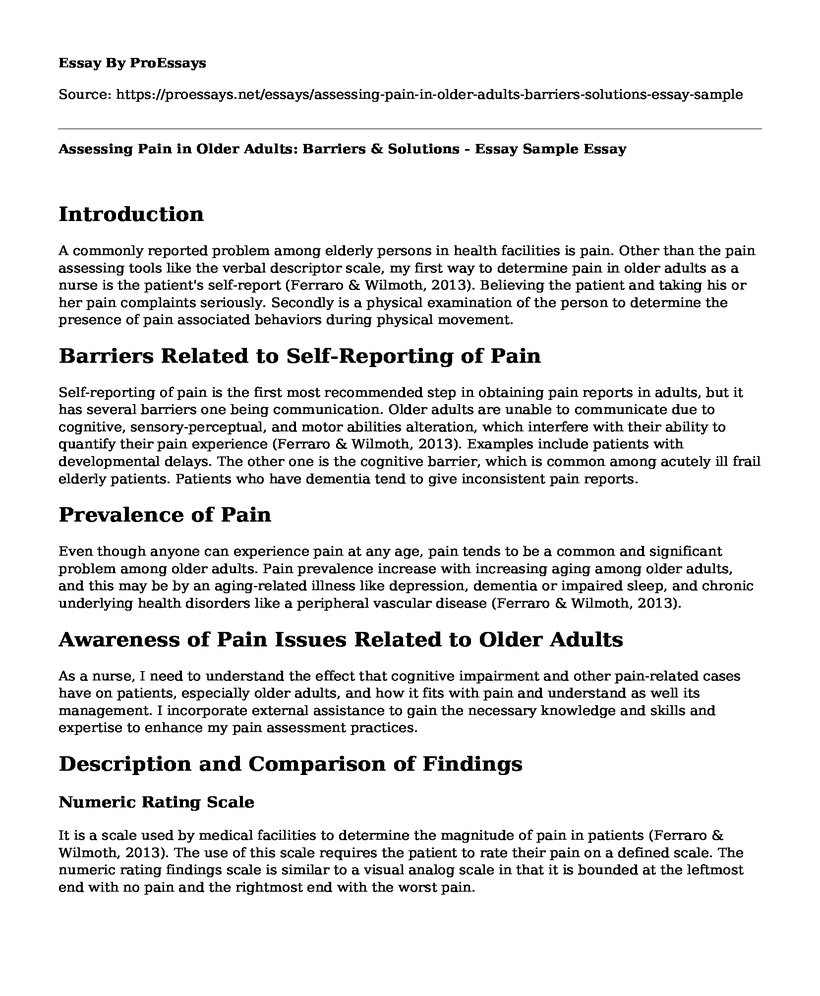Introduction
A commonly reported problem among elderly persons in health facilities is pain. Other than the pain assessing tools like the verbal descriptor scale, my first way to determine pain in older adults as a nurse is the patient's self-report (Ferraro & Wilmoth, 2013). Believing the patient and taking his or her pain complaints seriously. Secondly is a physical examination of the person to determine the presence of pain associated behaviors during physical movement.
Barriers Related to Self-Reporting of Pain
Self-reporting of pain is the first most recommended step in obtaining pain reports in adults, but it has several barriers one being communication. Older adults are unable to communicate due to cognitive, sensory-perceptual, and motor abilities alteration, which interfere with their ability to quantify their pain experience (Ferraro & Wilmoth, 2013). Examples include patients with developmental delays. The other one is the cognitive barrier, which is common among acutely ill frail elderly patients. Patients who have dementia tend to give inconsistent pain reports.
Prevalence of Pain
Even though anyone can experience pain at any age, pain tends to be a common and significant problem among older adults. Pain prevalence increase with increasing aging among older adults, and this may be by an aging-related illness like depression, dementia or impaired sleep, and chronic underlying health disorders like a peripheral vascular disease (Ferraro & Wilmoth, 2013).
Awareness of Pain Issues Related to Older Adults
As a nurse, I need to understand the effect that cognitive impairment and other pain-related cases have on patients, especially older adults, and how it fits with pain and understand as well its management. I incorporate external assistance to gain the necessary knowledge and skills and expertise to enhance my pain assessment practices.
Description and Comparison of Findings
Numeric Rating Scale
It is a scale used by medical facilities to determine the magnitude of pain in patients (Ferraro & Wilmoth, 2013). The use of this scale requires the patient to rate their pain on a defined scale. The numeric rating findings scale is similar to a visual analog scale in that it is bounded at the leftmost end with no pain and the rightmost end with the worst pain.
Visual Analog Scale
This is a pain rating scale that is validated and subjective to measure acute and chronic pain (Ferraro & Wilmoth, 2013). The scores for the pain are based on self-reported measures of symptoms, which are recorded by making a mark by hands on line that is about 10 centimeters, which represent a continuum between no pain and worst pain.
McGill Pain Questionnaire
It is a measure of pain by self-reports studied with several diagnoses, and it measures both the intensity and quality of the pain. It is always composed of 78 words with different categories that patients who are the respondents choose those that best describe their experience of pain (Ferraro & Wilmoth, 2013). The score is obtained by summing values associated with each word, and scores range from 0 to 78, with zero being no pain and 78 indicating severe pain (Ferraro & Wilmoth, 2013).
Pain in Dementia Patient
Dementia is a condition characterized by different signs like a decline in language and memory (Ferraro & Wilmoth, 2013). Patients with dementia feel the pain, which may be assessed by checking changes in a facial expression like grimacing. A faster heart rate and behavioral changes such as restlessness and agitation may also be checked. The standard scale used in assessing pain in dementia patients is the Pain Assessment in Advanced Dementia Scale, which can be used in both verbal and non-verbal patients (Ferraro & Wilmoth, 2013).
Reference
Ferraro, K. F., & Wilmoth, J. M. (Eds.). (2013). Gerontology: Perspectives and issues. Springer Publishing Company. https://books.google.co.ke/books?hl=en&lr=&id=VLNXeBW7DfQC&oi=fnd&pg=PP1&dq
Cite this page
Assessing Pain in Older Adults: Barriers & Solutions - Essay Sample. (2023, Apr 14). Retrieved from https://proessays.net/essays/assessing-pain-in-older-adults-barriers-solutions-essay-sample
If you are the original author of this essay and no longer wish to have it published on the ProEssays website, please click below to request its removal:
- Paper Example on Patient Teaching Plan
- Flood Preparation and Evacuation in Puyallup by Pierce County Emergency Management
- Nursing Shortage: Presenting the Problem Paper Example
- Comparison Between the US and Canada Health Systems Annotated Bibliography
- Comparing Ulcerative Colitis and Crohn's Disease - Essay Sample
- Oncology Nurses: Providing Physical & Psychological Care for Cancer Patients - Essay Sample
- Heroes Act of 2020: $3T Injection to Compensate Covid-19 Effects - Essay Sample







